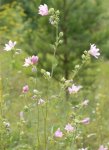Althaea officinalis althaea officinalis l.
Family Malvaceae - Malvaceae
Botanical characteristics. Perennial greyish-green herbaceous plant 120-150 cm high.
Rhizome thick, short, branched; Main root woody, lateral fleshy, gray outside, inside white. Stems single or numerous, slightly branched. Leaves alternate petiolate, upper whole, ovate, middle and lower without blades or shallow three-lobed, crenate, soft and densely pubescent, especially on the lower side. Flowers on short stalks are sitting in the axils of leaves; Corolla pale pink, white or reddish pink. Fruit - a disc-like multisen, in a mature state it breaks up into separate fruits. Seeds are dark-brown, glabrous, smooth, kidney-shaped. Blossoms from June to September. Fruits begin to ripen in September-October.
Spread. It grows in meadows, especially saline, in coastal thickets and bushes, along marshy lowlands, banks of irrigation ditches, deposits in solonchaks; Singly, rarely in groups.
Used parts of the plant. Medicinal raw materials are roots, rarely the aboveground part of the plant (flowers, leaves, seeds). Raw materials are collected in the usual way and dried outdoors in the shade.
Chemical composition. All organs of the plant contain mucus (23 and 4.7% - extraction by cold and hot water, respectively). Roots contain carbohydrates, mucus. In the mucus, galacturonic acid, pentoses, pentosans, hexosans, uronic acids: arabinose, rhamnose, glucose, galactose, neutral polysaccharides - arabinan, galactan and their derivatives; Organic acids, essential oil, rubbery substances, phytosterols, tannins, fatty oil, mineral salts, vitamins.
The leaves contain carbohydrates: essential oil, rubbery substances. Flowers contain essential oil with the smell of valerian.
Seeds contain fatty oil, in its composition acids: oleic, linoleic, linolenic; Phospholipids: fitin.
Althaeus is officially recognized as a medicine in many countries of Western Europe, North and South America, and Japan. Roots were included in all domestic pharmacopoeias. The leaves are official in the countries of Central Europe and Turkey; Flowers - in Belgium, France, the Netherlands.
Application. In scientific medicine, root powder, infusion and syrup are used as expectorant and anti-inflammatory in diseases of the respiratory tract and in the composition of the puerperium. Syrup is used to correct the taste of medicines and in cough medicines used in children's practice.
In folk medicine of many countries infusion and decoction of the roots are used for tuberculosis, cough, bronchitis, bronchial asthma, for washing the eyes with blepharitis; For the treatment of gastritis, enterocolitis, cystitis, diarrhea, for the elimination of irritation in inflammatory and ulcerative processes, since the aqueous extract, applied internally, is enveloping, covers a thin layer of mucous membranes, and retains them for a long time and thereby protects the mucous membranes from further Irritation, and also can slow the absorption of various soluble drugs at large doses taken. Acting as a protector vegetable mucus, soften inflammatory plaque (for example, on the mucous throat and larynx). Outwardly, the althea preparations are used for burns, dermatomycosis, furunculosis, scabies, pustular diseases, allergic dermatoses, tumors.
The root of the althaea is a typical representative of medicines related to mucus, it is almost equal in content of active compounds to flax seeds.
There is information in the literature that althea preparations soften tumors, and interfere with the formation, dissolve blood tumors that promote ripening of the abscess and their healing. Noteworthy are clinical observations on the use of althea in eczema and psoriasis. As a result of the treatment, the improvement was largely observed in the majority of patients.
Preparation
- For broth take 6 g of raw materials, put in enameled dishes, pour 200 ml of boiling water, cover with a lid, heat in a boiling water bath for 30 minutes, cool at room temperature for 10 minutes, filter. The remaining raw material is squeezed, adjusted to 200 ml. Store in a cool place. Take 1/3 cup 3 times daily after meals.
- The drug " Mukaltin " is used as well as marshmallow: according to the doctor's prescription. This drug is especially useful for children, according to the doctors' instructions.
When influenza altey often used in combination with other plants (mother-and-stepmother, oregano, etc.).




Comments
When commenting on, remember that the content and tone of your message can hurt the feelings of real people, show respect and tolerance to your interlocutors even if you do not share their opinion, your behavior in the conditions of freedom of expression and anonymity provided by the Internet, changes Not only virtual, but also the real world. All comments are hidden from the index, spam is controlled.